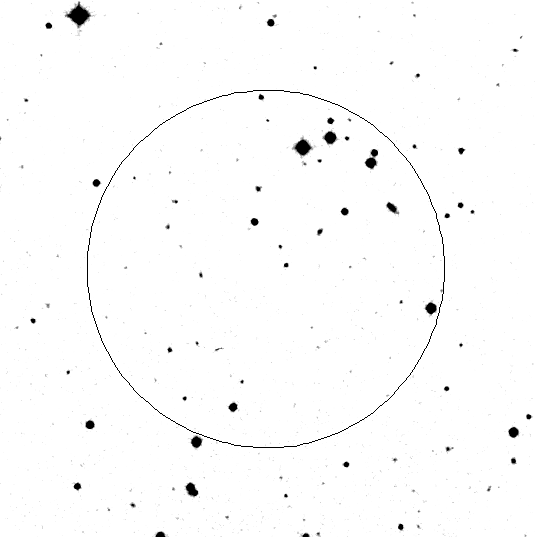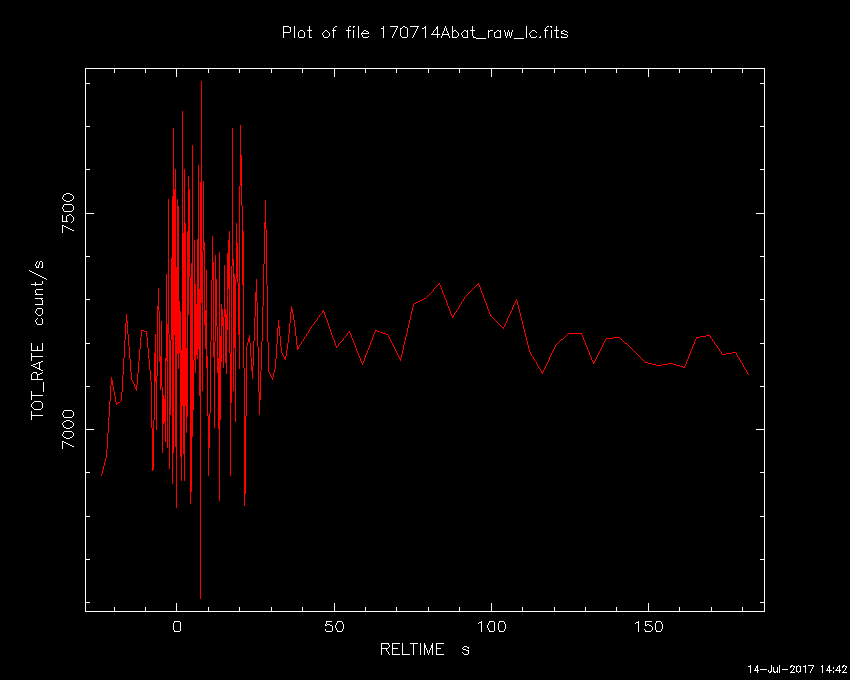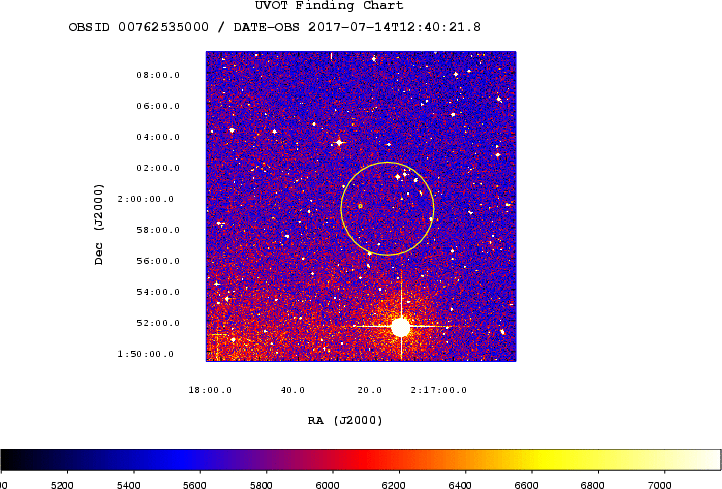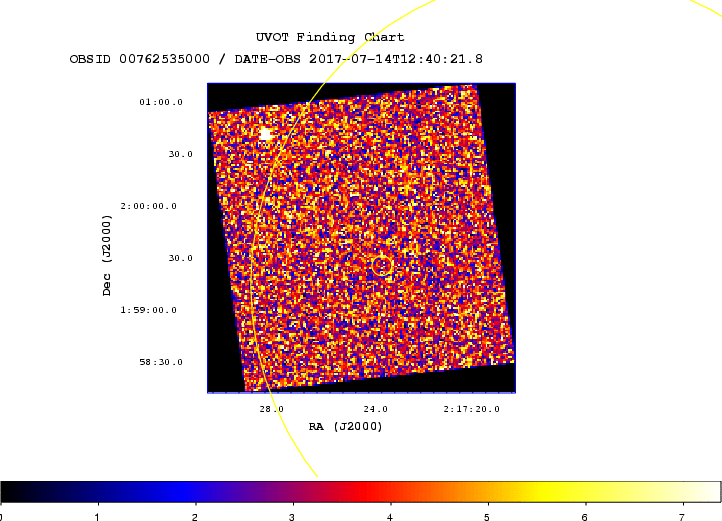(All information courtesy of the instrument teams.)
![]() Previous IAU Circulars
Previous IAU Circulars
TITLE: GCN/SWIFT NOTICE
NOTICE_DATE: Fri 14 Jul 17 12:40:49 UT
NOTICE_TYPE: Swift-BAT GRB Position
TRIGGER_NUM: 762535, Seg_Num: 0
GRB_RA: 34.321d {+02h 17m 17s} (J2000),
34.547d {+02h 18m 11s} (current),
33.675d {+02h 14m 42s} (1950)
GRB_DEC: +1.987d {+01d 59' 14"} (J2000),
+2.068d {+02d 04' 03"} (current),
+1.756d {+01d 45' 23"} (1950)
GRB_ERROR: 3.00 [arcmin radius, statistical only]
GRB_INTEN: 0 [cnts] Image_Peak=4304 [image_cnts]
TRIGGER_DUR: 320.000 [sec] (=5.3 [min])
TRIGGER_INDEX: 20000 E_range: 15-50 keV
BKG_INTEN: 0 [cnts]
BKG_TIME: 0.00 SOD {00:00:00.00} UT
BKG_DUR: 0 [sec]
GRB_DATE: 17948 TJD; 195 DOY; 17/07/14
GRB_TIME: 44732.63 SOD {12:25:32.63} UT
GRB_PHI: 112.46 [deg]
GRB_THETA: 24.09 [deg]
SOLN_STATUS: 0x13
RATE_SIGNIF: 0.00 [sigma]
IMAGE_SIGNIF: 8.63 [sigma]
MERIT_PARAMS: +1 +0 +0 +6 +1 -1 +0 +0 -17 +0
SUN_POSTN: 114.05d {+07h 36m 12s} +21.60d {+21d 35' 47"}
SUN_DIST: 79.48 [deg] Sun_angle= 5.3 [hr] (West of Sun)
MOON_POSTN: 355.39d {+23h 41m 33s} -4.85d {-04d 50' 58"}
MOON_DIST: 39.73 [deg]
MOON_ILLUM: 74 [%]
GAL_COORDS: 161.72,-54.29 [deg] galactic lon,lat of the burst (or transient)
ECL_COORDS: 32.74,-11.09 [deg] ecliptic lon,lat of the burst (or transient)
COMMENTS: SWIFT-BAT GRB Coordinates.
COMMENTS: This Notice was delayed by more than 60 sec past the end of the trigger integration interval;
COMMENTS: probably due to it occurring during a Malindi downlink session.
COMMENTS: This is an image trigger. (The RATE_SIGNIF & BKG_{INTEN, TIME, DUR} are undefined.)
COMMENTS: A point_source was found.
COMMENTS: This does not match any source in the on-board catalog.
COMMENTS: This does not match any source in the ground catalog.
COMMENTS: This is a GRB.
COMMENTS: This trigger occurred at longitude,latitude = 258.28,19.75 [deg].

TITLE: GCN/SWIFT NOTICE
NOTICE_DATE: Fri 14 Jul 17 12:41:20 UT
NOTICE_TYPE: Swift-XRT Position
TRIGGER_NUM: 762535, Seg_Num: 0
GRB_RA: 34.3498d {+02h 17m 23.95s} (J2000),
34.5764d {+02h 18m 18.33s} (current),
33.7042d {+02h 14m 49.00s} (1950)
GRB_DEC: +1.9901d {+01d 59' 24.3"} (J2000),
+2.0706d {+02d 04' 14.0"} (current),
+1.7594d {+01d 45' 33.7"} (1950)
GRB_ERROR: 5.0 [arcsec radius, statistical plus systematic, 90% containment]
GRB_INTEN: 2.46e-09 [erg/cm2/sec]
GRB_SIGNIF: 9.11 [sigma]
IMG_START_DATE: 17948 TJD; 195 DOY; 17/07/14
IMG_START_TIME: 45125.31 SOD {12:32:05.31} UT, 392.7 [sec] since BAT Trigger Time
TAM[0-3]: 327.68 237.20 261.74 243.55
AMPLIFIER: 2
WAVEFORM: 134
SUN_POSTN: 114.05d {+07h 36m 12s} +21.60d {+21d 35' 47"}
SUN_DIST: 79.45 [deg] Sun_angle= 5.3 [hr] (West of Sun)
MOON_POSTN: 355.39d {+23h 41m 34s} -4.85d {-04d 50' 53"}
MOON_DIST: 39.76 [deg]
MOON_ILLUM: 74 [%]
GAL_COORDS: 161.76,-54.27 [deg] galactic lon,lat of the burst
ECL_COORDS: 32.77,-11.10 [deg] ecliptic lon,lat of the burst
COMMENTS: SWIFT-XRT Coordinates.
COMMENTS: The XRT position is 1.76 arcmin from the BAT position.
TITLE: GCN/SWIFT NOTICE
NOTICE_DATE: Fri 14 Jul 17 12:41:30 UT
NOTICE_TYPE: Swift-XRT Image
TRIGGER_NUM: 762535, Seg_Num: 0
GRB_RA: 34.3498d {+02h 17m 23.9s} (J2000),
34.5764d {+02h 18m 18.3s} (current),
33.7042d {+02h 14m 49.0s} (1950)
GRB_DEC: +1.9901d {+01d 59' 24.3"} (J2000),
+2.0706d {+02d 04' 14.0"} (current),
+1.7594d {+01d 45' 33.7"} (1950)
GRB_ERROR: 5.0 [arcsec, radius, statistical plus systematic]
GRB_INTEN: 83 [cnts]
IMG_START_DATE: 17948 TJD; 195 DOY; 17/07/14
IMG_START_TIME: 45125.31 SOD {12:32:05.31} UT, 392.7 [sec] since BAT Trigger Time
CENTROID_X: 296.03, raw= 296 [pixels]
CENTROID_Y: 295.73, raw= 296 [pixels]
ROLL: 68.38 [deg]
GAIN: 1
MODE: 3, Long Image mode
WAVEFORM: 134
EXPO_TIME: 2.50 [sec]
GRB_POS_XRT_Y: -6.27
GRB_POS_XRT_Z: -24.42
IMAGE_URL: sw00762535000msxps_rw.img
SUN_POSTN: 114.05d {+07h 36m 12s} +21.60d {+21d 35' 47"}
SUN_DIST: 79.45 [deg] Sun_angle= 5.3 [hr] (West of Sun)
MOON_POSTN: 355.39d {+23h 41m 34s} -4.85d {-04d 50' 51"}
MOON_DIST: 39.75 [deg]
MOON_ILLUM: 74 [%]
GAL_COORDS: 161.76,-54.27 [deg] galactic lon,lat of the burst
ECL_COORDS: 32.77,-11.10 [deg] ecliptic lon,lat of the burst
COMMENTS: SWIFT-XRT Image.

TITLE: GCN/SWIFT NOTICE
NOTICE_DATE: Fri 14 Jul 17 12:41:33 UT
NOTICE_TYPE: Swift-XRT Processed Image
TRIGGER_NUM: 762535, Seg_Num: 0
GRB_RA: 34.3498d {+02h 17m 23.9s} (J2000),
34.5764d {+02h 18m 18.3s} (current),
33.7042d {+02h 14m 49.0s} (1950)
GRB_DEC: +1.9901d {+01d 59' 24.3"} (J2000),
+2.0706d {+02d 04' 14.0"} (current),
+1.7594d {+01d 45' 33.7"} (1950)
GRB_ERROR: 5.0 [arcsec, radius, statistical plus systematic]
GRB_INTEN: 83 [cnts]
IMG_START_DATE: 17948 TJD; 195 DOY; 17/07/14
IMG_START_TIME: 45125.31 SOD {12:32:05.31} UT, 392.7 [sec] since BAT Trigger Time
CENTROID_X: 296.03, raw= 296 [pixels]
CENTROID_Y: 295.73, raw= 296 [pixels]
ROLL: 68.38 [deg]
GAIN: 1
MODE: 3, Long Image mode
WAVEFORM: 134
EXPO_TIME: 2.50 [sec]
GRB_POS_XRT_Y: -6.27
GRB_POS_XRT_Z: -24.42
IMAGE_URL: sw00762535000msxps_rw.img
SUN_POSTN: 114.05d {+07h 36m 12s} +21.60d {+21d 35' 47"}
SUN_DIST: 79.45 [deg] Sun_angle= 5.3 [hr] (West of Sun)
MOON_POSTN: 355.39d {+23h 41m 34s} -4.85d {-04d 50' 51"}
MOON_DIST: 39.75 [deg]
MOON_ILLUM: 74 [%]
GAL_COORDS: 161.76,-54.27 [deg] galactic lon,lat of the burst
ECL_COORDS: 32.77,-11.10 [deg] ecliptic lon,lat of the burst
COMMENTS: SWIFT-XRT Processed Image.

TITLE: GCN/SWIFT NOTICE
NOTICE_DATE: Fri 14 Jul 17 12:41:56 UT
NOTICE_TYPE: Swift-BAT GRB Lightcurve
TRIGGER_NUM: 762535, Seg_Num: 0
GRB_RA: 34.321d {+02h 17m 17s} (J2000),
34.547d {+02h 18m 11s} (current),
33.675d {+02h 14m 42s} (1950)
GRB_DEC: +1.987d {+01d 59' 14"} (J2000),
+2.068d {+02d 04' 03"} (current),
+1.756d {+01d 45' 23"} (1950)
GRB_DATE: 17948 TJD; 195 DOY; 17/07/14
GRB_TIME: 44732.63 SOD {12:25:32.63} UT
TRIGGER_INDEX: 20000
GRB_PHI: 112.46 [deg]
GRB_THETA: 24.09 [deg]
DELTA_TIME: 0.00 [sec]
TRIGGER_DUR: 320.000 [sec] (=5.3 [min])
SOLN_STATUS: 0x13
RATE_SIGNIF: 0.00 [sigma]
IMAGE_SIGNIF: 8.63 [sigma]
LC_URL: sw00762535000msb.lc
SUN_POSTN: 114.05d {+07h 36m 12s} +21.60d {+21d 35' 47"}
SUN_DIST: 79.48 [deg] Sun_angle= 5.3 [hr] (West of Sun)
MOON_POSTN: 355.40d {+23h 41m 35s} -4.85d {-04d 50' 47"}
MOON_DIST: 39.72 [deg]
MOON_ILLUM: 74 [%]
GAL_COORDS: 161.72,-54.29 [deg] galactic lon,lat of the burst (or transient)
ECL_COORDS: 32.74,-11.09 [deg] ecliptic lon,lat of the burst (or transient)
COMMENTS: SWIFT-BAT GRB Lightcurve.
COMMENTS:
COMMENTS: The next comments were copied from the BAT_POS Notice:
COMMENTS: This is an image trigger.
COMMENTS: A point_source was found.
COMMENTS: This does not match any source in the on-board catalog.
COMMENTS: This does not match any source in the ground catalog.
COMMENTS: This is a GRB.
COMMENTS: This trigger occurred at longitude,latitude = 258.28,19.75 [deg].

TITLE: GCN/SWIFT NOTICE
NOTICE_DATE: Fri 14 Jul 17 12:43:12 UT
NOTICE_TYPE: Swift-UVOT Source List
TRIGGER_NUM: 762535, Seg_Num: 0
POINT_RA: 34.345d {+02h 17m 23s} (J2000)
POINT_DEC: +1.989d {+01d 59' 20"} (J2000)
POINT_ROLL: 68.381d
IMG_START_DATE: 17948 TJD; 195 DOY; 17/07/14
IMG_START_TIME: 45602.44 SOD {12:40:02.44} UT, 869.8 [sec] since BAT Trigger Time
FILTER: 7, U
BKG_MEAN: 0.946
N_STARS: 27
X_OFFSET: 271 [pixels]
Y_OFFSET: 302 [pixels]
X_MAX: 1710 [pixels]
Y_MAX: 1741 [pixels]
DET_THRESH: 8
PHOTO_THRESH: 4
SL_URL: sw00762535000msufc0869.fits
SUN_POSTN: 114.05d {+07h 36m 13s} +21.60d {+21d 35' 46"}
SUN_DIST: 79.46 [deg] Sun_angle= 5.3 [hr] (West of Sun)
MOON_POSTN: 355.41d {+23h 41m 38s} -4.84d {-04d 50' 34"}
MOON_DIST: 39.73 [deg]
MOON_ILLUM: 74 [%]
GAL_COORDS: 161.75,-54.27 [deg] galactic lon,lat of the pointing direction
ECL_COORDS: 32.77,-11.10 [deg] ecliptic lon,lat of the pointing direction
COMMENTS: SWIFT-UVOT Source List.
TITLE: GCN/SWIFT NOTICE
NOTICE_DATE: Fri 14 Jul 17 12:43:29 UT
NOTICE_TYPE: Swift-UVOT Processed Source List
TRIGGER_NUM: 762535, Seg_Num: 0
POINT_RA: 34.345d {+02h 17m 23s} (J2000)
POINT_DEC: +1.989d {+01d 59' 20"} (J2000)
POINT_ROLL: 68.381d
IMG_START_DATE: 17948 TJD; 195 DOY; 17/07/14
IMG_START_TIME: 45602.44 SOD {12:40:02.44} UT, 869.8 [sec] since BAT Trigger Time
FILTER: 7, U
BKG_MEAN: 0.946
N_STARS: 27
X_OFFSET: 271 [pixels]
Y_OFFSET: 302 [pixels]
X_MAX: 1710 [pixels]
Y_MAX: 1741 [pixels]
DET_THRESH: 8
PHOTO_THRESH: 4
SL_URL: sw00762535000msufc0869.fits
SUN_POSTN: 114.05d {+07h 36m 13s} +21.60d {+21d 35' 46"}
SUN_DIST: 79.46 [deg] Sun_angle= 5.3 [hr] (West of Sun)
MOON_POSTN: 355.41d {+23h 41m 38s} -4.84d {-04d 50' 31"}
MOON_DIST: 39.73 [deg]
MOON_ILLUM: 74 [%]
GAL_COORDS: 161.75,-54.27 [deg] galactic lon,lat of the pointing direction
ECL_COORDS: 32.77,-11.10 [deg] ecliptic lon,lat of the pointing direction
COMMENTS: SWIFT-UVOT Processed Source List.
COMMENTS: All 4 attachments are included.

TITLE: GCN/SWIFT NOTICE
NOTICE_DATE: Fri 14 Jul 17 12:44:20 UT
NOTICE_TYPE: Swift-UVOT Image
TRIGGER_NUM: 762535, Seg_Num: 0
POINT_RA: 34.345d {+02h 17m 23s} (J2000)
POINT_DEC: +1.989d {+01d 59' 20"} (J2000)
ROLL: 68.381d
IMG_START_DATE: 17948 TJD; 195 DOY; 17/07/14
IMG_START_TIME: 45602.44 SOD {12:40:02.44} UT, 869.8 [sec] since BAT Trigger Time
FILTER: 7, U
EXPOSURE_ID: 521728821
X_OFFSET: 830 [pixels]
Y_OFFSET: 861 [pixels]
WIDTH: 160 [pixels]
HEIGHT: 160 [pixels]
X_GRB_POS: 990
Y_GRB_POS: 1021
BINNING_INDEX: 1
IM_URL: sw00762535000msuni0889.fits
SUN_POSTN: 114.05d {+07h 36m 13s} +21.60d {+21d 35' 46"}
SUN_DIST: 79.46 [deg] Sun_angle= 5.3 [hr] (West of Sun)
MOON_POSTN: 355.42d {+23h 41m 40s} -4.84d {-04d 50' 22"}
MOON_DIST: 39.72 [deg]
MOON_ILLUM: 74 [%]
GAL_COORDS: 161.75,-54.27 [deg] galactic lon,lat of the pointing direction
ECL_COORDS: 32.77,-11.10 [deg] ecliptic lon,lat of the pointing direction
COMMENTS: SWIFT-UVOT Image.
COMMENTS: The GRB Position came from the Window Position in the Mode Command.
COMMENTS: The image has 2x2 binning (compression).

TITLE: GCN/SWIFT NOTICE
NOTICE_DATE: Fri 14 Jul 17 12:44:35 UT
NOTICE_TYPE: Swift-UVOT Processed Image
TRIGGER_NUM: 762535, Seg_Num: 0
POINT_RA: 34.345d {+02h 17m 23s} (J2000)
POINT_DEC: +1.989d {+01d 59' 20"} (J2000)
ROLL: 68.381d
IMG_START_DATE: 17948 TJD; 195 DOY; 17/07/14
IMG_START_TIME: 45602.44 SOD {12:40:02.44} UT, 869.8 [sec] since BAT Trigger Time
FILTER: 7, U
EXPOSURE_ID: 521728821
X_OFFSET: 830 [pixels]
Y_OFFSET: 861 [pixels]
WIDTH: 160 [pixels]
HEIGHT: 160 [pixels]
X_GRB_POS: 990
Y_GRB_POS: 1021
BINNING_INDEX: 1
IM_URL: sw00762535000msuni0889.fits
SUN_POSTN: 114.05d {+07h 36m 13s} +21.60d {+21d 35' 46"}
SUN_DIST: 79.46 [deg] Sun_angle= 5.3 [hr] (West of Sun)
MOON_POSTN: 355.42d {+23h 41m 41s} -4.84d {-04d 50' 19"}
MOON_DIST: 39.72 [deg]
MOON_ILLUM: 74 [%]
GAL_COORDS: 161.75,-54.27 [deg] galactic lon,lat of the pointing direction
ECL_COORDS: 32.77,-11.10 [deg] ecliptic lon,lat of the pointing direction
COMMENTS: SWIFT-UVOT Processed Image.
COMMENTS: The GRB Position came from the Window Position in the Mode Command.
COMMENTS: The image has 2x2 binning (compression).
COMMENTS: All 4 attachments are included.

RA(J2000) = 02h 17m 17s Dec(J2000) = +01d 59' 14"with an uncertainty of 3 arcmin (radius, 90% containment, including systematic uncertainty). As is usual with an image trigger, the available BAT light curve shows no significant structure.
RA(J2000) = +02h 17m 23.95s Dec(J2000) = +01d 59' 24.4"with an uncertainty of 5.0 arcseconds (radius, 90% containment). This location is 104 arcseconds from the BAT onboard position, within the BAT error circle. No event data are yet available to determine the column density using X-ray spectroscopy.
RA (J2000): 02h 17m 23.96s Dec (J2000): +01d 59' 31.3"with an uncertainty of 1.8 arcsec (radius, 90% confidence).
Total column: 9.0 (+/-1.5) x 10^20 cm^-2 Galactic foreground: 3.6 x 10^20 cm^-2 Excess significance: 6.1 sigma Photon index: 1.73 (+/-0.05)The results of the XRT-team automatic analysis are available at http://www.swift.ac.uk/xrt_products/00762535.
R.A.: 02:17:23.99 Dec.: +01:59:29.51and a magnitude of z(AB)=22.3+/-0.2, which we identify as the possible GRB afterglow, although we cannot make any statement about variability at this time. In our preliminary analysis we do not detect the object in any other band, implying a possible strong reddening.
RA(J2000) = 02h 17m 17.3s Dec(J2000) = +01d 57' 43.3"with an uncertainty of 2.2 arcmin, (radius, sys+stat, 90% containment). The partial coding was 61%.
Filter T_start(s) T_stop(s) Exp(s) Mag v 384 1695 175 >18.6 b 496 1644 155 20.0 +/- 0.33 b 5390 24672 1011 >20.3 u 471 1619 284 20.1 +/- 0.35 u 5185 30412 2351 20.4 +/- 0.18 u 81432 92912 1509 >20.7 w1 446 1594 136 >21.0 m2 6006 29000 2637 >20.9 w2 5596 34449 3032 >22.0The magnitudes in the table are not corrected for the Galactic extinction due to the reddening of E(B-V) = 0.03 in the direction of the burst (Schlegel et al. 1998).
Filter T_start(s) T_stop(s) Exp(s) Mag v 397 1695 175 >18.6 b 496 1644 155 20.0 +/- 0.33 b 92917 93309 382 >20.3 u 471 1619 284 20.1 +/- 0.35 u 81432 92912 1509 >20.7 w1 446 1594 136 >21.0 m2 76276 98985 2438 >21.3 w2 74458 86274 1771 >21.5I apologize for any confusion caused by the earlier report.
RA: 2h17m24.02s DEC: +1d59'28.51"with an error of 1.3" (statistic + systematic, 90% confidence), consistent with the position of the optical counterpart (de Ugarte Postigo et al. GCN 21346) and of XRT (Evans et al. GCN 21341).
RA(J2000) = 02:17:23.97 Dec(J2000) = +01:59:29.72with a 68% uncertainty of 0.5 arcsec. This position is consistent with the XRT position (http://www.swift.ac.uk/xrt_positions/00762535/), and the optical source reported by de Ugarte Postigo et al. (GCN 21346). By adopting the spectral parameters of the Swift/XRT analysis (D'Avanzo et al., GCN 21343), we estimate an average X-ray flux of ~1.1E-14 erg/cm2/s during our observation. This is consistent with a late-time power-law decay of slope ~-1.
RA: 02h17m23.96s Dec: +01:59'32.9"with a 90% error of ~2.5" in DEC and ~0.1" in RA, consistent with the position of the GRB X-ray counterpart by Chandra (Troja et al. GCN 21396) and the optical source reported by de Ugarte Postigo et al. (GCN 21346).